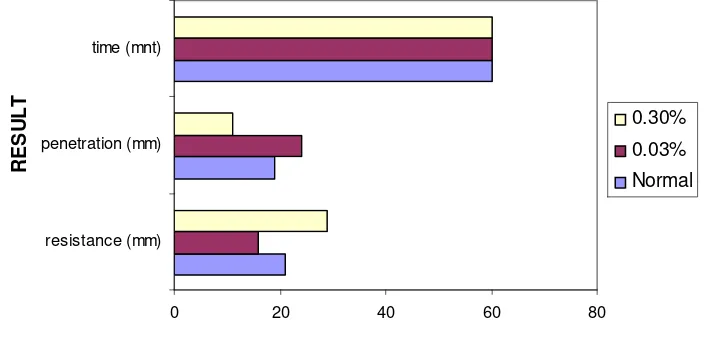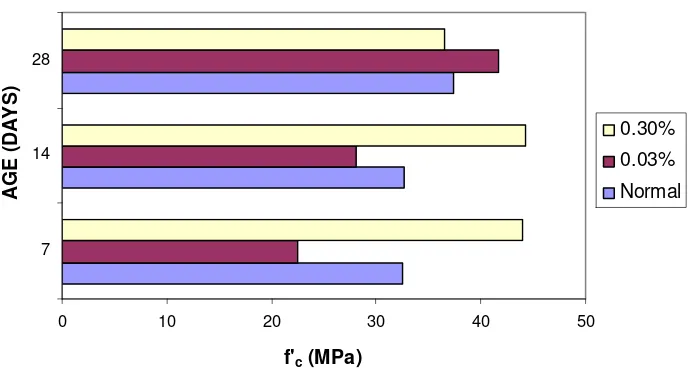THE USING OF SUGAR CANE LIQUID AS ‘GREEN’ RETARDER AND
ACCELERATOR FOR CONCRETE MIXTURE
Rr. M.I. Retno Susilorini
1, Robert Indarko Ganis
2, Hartaman Aris Nugraha
3, Imam
Syaefudin
4, Sunu Ardi B
51
Lecturer, Department of Civil Engineering, Faculty of Engineering, Soegijapranata Catholic University, Jl. Pawiyatan Luhur IV/1, Bendan Dhuwur, Semarang 50234
24
Alumnus, Department of Civil Engineering, Faculty of Engineering, Soegijapranata Catholic University, Jl. Pawiyatan Luhur IV/1, Bendan Dhuwur, Semarang 50234
35
Student, Department of Civil Engineering, Faculty of Engineering, Soegijapranata Catholic University, Jl. Pawiyatan Luhur IV/1, Bendan Dhuwur, Semarang 50234
Email: [email protected]; [email protected]
Abstract
Sugar is well-known as good retarder to delay the concrete hardening. It is interesting to find another source of natural sugar, it is sugar cane liquid, to become ‘green’ retarder and accelerator concrete admixture. The research tries to deliver two extreme dosages of sugar cane liquid retarder admixture as 0.03% and 0.3% of cement weight. The specimens are categorized in mortar cubes and concrete cylinders with compressive strength design f’c = 30 MPa. They are vary in plain, added with sugar cane liquid 0.03% of cement weight, and added with sugar cane liquid 0.3% of cement weight. The curing conducted for 7, 14, and 28 days and then tested for its compressive strength. The mortar surface hardening is observed by trinoculer electronic microscope. This research meets conclusions as follow: (1) The sugar cane liquidas can be used as ‘green’ concrete admixture, (2) The dosage of sugar cane liquid admixture of 0.03% by weight of cement can perform as retarder because its value of compressive strength on days 7 and 14 is the lowest compared to plain mortar; the surface of mortar seems wet and softer; and the Vicat test shows that the penetration time is the highest compared to the plain mortar and the mortar with sugar cane liquid admixture of 0.03% by weight of cement while its resistance is the lowest, (3) The dosage of sugar admixture of 0.3% by weight of cement can perform as accelerator because its value of compressive strength on days 7 and 14 is the highest compared to plain mortar; the surface of mortar seems harder and smoother; and the Vicat test shows that the penetration time is the lowest compared to the mortar with sugar admixture of 0.03% by weight of cement while its resistance is the highest, and (4) It is still questioned whether the compressive strength value increase or decrease on the older ages
Keywords: accelerator; concrete; ‘green’ material; retarder; sugar cane liquid
Introduction
Sugar is well-known as good retarder to delay the concrete hardening. It is interesting to find another source of natural sugar, it is sugar cane liquid, to become ‘green’ retarder and accelerator concrete admixture. Sugar cane is popular as raw material for sugar production. The sugar is believed as good concrete retarder to delay cement setting (Jayakumaran, 2005; Medjo Eko and Rikowski, 2001). Previous researches have proved that sugar cane can increase the performance of bricks (Medjo Eko and Rikowski, 2001) and performs very high pozzolanic activity (Fries, et. al., 2007). While the environmental revitalization is necessary need, then the ‘green concrete’ with sugar cane as ingredients will fulfill the need.
Method of Research
Several mortar cubes and concrete cylinders specimens are used with compressive strength design f’c = 30 MPa and divided into variant of plain, added by sugar cane liquid admixture of 0.03% by cement weight, and added sugar cane liquid admixture of 0.3% by cement weight. The sugar cane liquid is produced by extracting the sugar cane bar to get its juice or extract liquid. All specimens are cured for 7, 14, and 28 days, and then tested for its compressive strength. There is also an observation of mortar surface hardening by trinoculer electronic microscope.
Results and Discussion
Sugar is known as retarder which makes the early hydration of C3S getting slows down by extending the length of cement dormant period (Medjo Eko and Rikowski, 2001). Mindess and Young (1981) emphasizes that the length of cement dormant period is proportional with the amount of retarder admixture given in concrete mix. When concrete is added by sugar with amount exceeds 0.5 g/l of concrete, then the dormant period will not exist and the cement paste will never set. Therefore, it is important to know that the dosage of sugar cane liquid admixture of 0.03% and 0.3% by weight of cement perform effectively as retarder or accelerator.
The experimental result of Vicat test (Ganis and Nugraha, 2008; Syaefudin and Ardi, 2008) is shown by Figure 1. It shows that for the same duration (60 minutes), the penetration of mortar with sugar cane liquid addition of 0.03% by weight of cement is deeper compared to plain mortar and mortar with sugar cane liquid addition of 0.3% by weight of cement. Thus, the penetration of mortar with sugar cane liquid addition of 0.3% by weight of cement is shallower compared to others. While the penetration value of mortar with sugar cane liquid addition of 0.3% by weight of cement is the smallest, then its resistance value is the biggest
0 20 40 60 80
Figure 1. The Vicat test result of plain mortar and
mortar with sugar cane liquid admixture (0.03% and 0.3% by weight of cement) (Modified from Ganis and Nugraha, 2008; Syaefudin and Ardi, 2008)
0 10 20 30 40 50
Figure 2. The mortar compressive strength of normal concrete and concrete with sugar cane liquid admixture (0.03% and 0.3% by weight of cement)
(Modified from Ganis and Nugraha, 2008; Syaefudin and Ardi, 2008)
Figure 3 describes the concrete compressive strength of normal concrete and concrete with sugar cane liquid admixture of 0.03% and 0.3% by weight of cement (Ganis and Nugraha, 2008; Syaefudin and Ardi, 2008). The same phenomenon happened as found in mortar compressive strength case. It is found that concrete with sugar cane liquid admixture of 0.03% by cement weight have the lowest compressive strength for days 7 and 14 as 25.27 MPa and 27.86 MPa compared to plain mortar and sugar cane liquid admixture of 0.3% by cement weight. The concrete with sugar cane liquid admixture of 0.3% by cement weight has the highest position on days 7 and 14 as 30.75 MPa and 31.12 MPa compared to others. Thus, it is questioned, why the compressive strength of mortar and concrete with sugar cane liquid admixture of 0.3% by cement weight sharply goes down on days 28. Is it going to achieved better value on older ages or not?
Figure 3. The concrete compressive strength of normal concrete and concrete with sugar cane liquid admixture (0.03% and 0.3% by weight of cement)
(Modified from Ganis and Nugraha, 2008; Syaefudin and Ardi, 2008)
of mortar on day 2 and 4 with sugar cane liquid admixture 0.3% by weight of cement is harder and smoother compared to plain mortar and mortar with sugar cane liquid admixture 0.03% by weight of cement. It is also found that the surface of mortar with sugar cane liquid admixture 0.3% by weight of cement on day 2 and day 4 seems wet and softer compared to plain mortar and mortar with sugar admixture 0.03% by weight of cement. This visual observation of mortar hardening proves that the sugar cane liquid admixture 0.03% by weight of cement obviously delay the cement setting while the sugar cane liquid admixture 0.3% by weight of cement is the opposite.
(a) (b) (c)
(d) (e) (f)
Figure 4. Trinoculer electronic microscope observation result (a) plain mortar on day 2
(b) mortar with sugar cane liquid admixture 0.03% by weight of cement on day 2 (c) mortar with sugar cane liquid admixture 0.3% by weight of cement on day 2
(d) plain mortar on day 4
(e) mortar with sugar cane liquid admixture 0.03% by weight of cement on day 4 (f) mortar with sugar cane liquid admixture 0.3% by weight of cement on day 4
(Ganis and Nugraha, 2008; Syaefudin and Ardi, 2008)
Oppositely, the sugar cane liquid admixture of 0.3% by weight of cement obviously performs as accelerator. The mortar and concrete compressive strength is the highest on early ages (days 7 and 14) compared to plain mortar and concrete. Nevertheless, it is still questioned whether the compressive strength value increase or decrease on the older ages. The observation of trinoculer electronic microscope supports that the surface of mortar with sugar cane liquid admixture of 0.3% by weight of cement is harder and smoother. As another reference, the Vicat test also shows that the depth of penetration of mortar with sugar cane liquid admixture of 0.3% by weight of cement is the lowest while the resistance is the highest compared to plain mortar and mortar with sugar cane liquid admixture of 0.03% by weight of cement.
Conclusions
This research meets conclusions as follow:
(1) The sugar cane liquidas can be used as ‘green’ concrete admixture
(2) The dosage of sugar cane liquid admixture of 0.03% by weight of cement can perform as retarder because its value of compressive strength on days 7 and 14 is the lowest compared to plain mortar; the surface of mortar seems wet and softer; and the Vicat test shows that the penetration time is the highest compared to the plain mortar and the mortar with sugar cane liquid admixture of 0.03% by weight of cement while its resistance is the lowest
(3) The dosage of sugar admixture of 0.3% by weight of cement can perform as accelerator because its value of compressive strength on days 7 and 14 is the highest compared to plain mortar; the surface of mortar seems harder and smoother; and the Vicat test shows that the penetration time is the lowest compared to the mortar with sugar admixture of 0.03% by weight of cement while its resistance is the highest
(4) It is still questioned whether the compressive strength value increase or decrease on the older ages
References
Chandler, Cristophe., Kharsan, Margarita., and Furman, Alla, (2002), “Sugar Beets Against Corrosion“, Corrosion Review Journal, Vol. 20, No. 4-5, pp.379-390, London, England.
Collepardi, Mario, (2005), “Chemical Admixtures Today”, Proceeding of Second International Symposium on Concrete Technology for Sustainable Development with Emphasis on Infrastructure, pp. 527-541, India.
Deutschen Bauchemie e.V., (2006), Concrete Mixture and Environment – State of Art Report, Frostcher, Darmstadt, Frankfurt.
Frias, Moises., Villar-Cocina, E., and Valencia-Morales, E., (2007) “Characterization of Sugar Cane Straw Waste as Pozzolanic Material for Construction: Calcinic Temperature and Kinetic Parameters”, Waste Management Journal, Vol. 27., pp. 533-538.
Ganis, R.I. and Nugraha, H.A., (2008) “Pengaruh Larutan Tebu 0.03% Sebagai Retarder Alami Terhadap Kuat Tekan Beton”, Undergraduate Thesis (Tugas Akhir), Program Studi Teknik Sipil, Unika Soegijapranata, Semarang.
Jayakumaran, al Govindasamzy, (2005), “The Effect of Over Dossage of Concrete Daratard 40 in Concrete”, Thesis, University Teknologi Malaysia.
Medjo Eko, R. and Riskowski, G.L, (2001), “A Procedure for Processing Mixtures of Soil, Cement, and Sugar Cane Bagasse”, Agricultural Engineering International-the CIGR Journal of Scientific Research and Development, Manuscript BC 99 001, Vol. III, pp. 1-11.
Mindess, S. and Young, F., (1981), “Concrete”, Prentice Hall Inc., Englewood Cliffs, New Jersey.
Morsy, Mohamed S. and Shebl, Sayed S, (2007), “Effect of Silicafume and Metakaoline Pozzolana on the Performance of Blended Cement Paste Against Fire”, Journal of Ceramics, Vol. 51, o. 1, pp. 40-44.
Nikodemus and Setiawan, B, (2008), “Pengaruh Penambahan Retarder Gula Pasir 0.03% dari Berat Semen Terhadap Kuat Tekan Beton”, Undergraduate Thesis (Tugas Akhir), Program Studi Teknik Sipil, Unika Soegijapranata, Semarang.
Suranto, Didit, (2008), “Aplikasi Standar Proctor pada Beton RCC (Roller Compacted Concrete) dengan Additive (Gula Pasir)”, Thesis, Universitas Gajah Mada.


